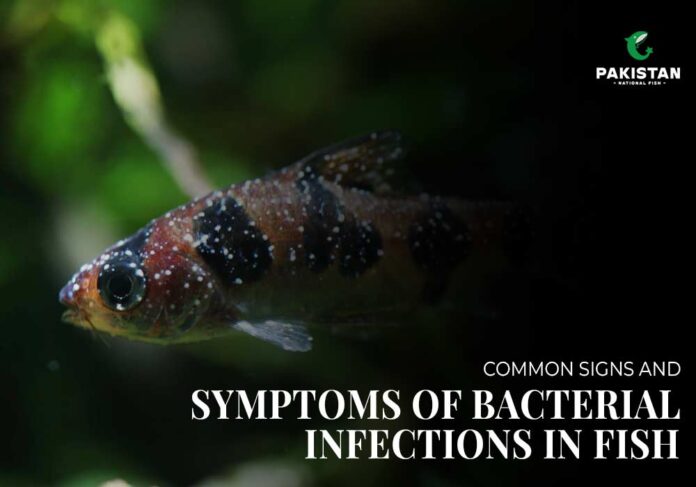Some of the diseases that affect fish are many but bacterial diseases are common among fish. Such infections may be caused by water pollution, stress, injury, or the addition of affected fish to a tank or pond. It is equally important to know the signs and symptoms of primary bacterial infection in fish to be in a position to clinically prevent their occurrence.
For that reason, here we shall discuss more about the signs, causes, cure, and prevention of bacterial infections in fish.
Causes Of Bacterial Infections In Fish
The diseases in fish are mainly secondary infections from environmental bacteria that invade the fish when they are hosted by a stressed fish. Some of the most common bacteria responsible for infections include:
- Aeromonas spp: Common with ulcerative diseases septicemia as well as fin rot.
- Pseudomonas spp: Associated with ulcers, skin lesions, and systemic infections.
- Vibrio spp: Another pathogen developed in saltwater fish which is Vibriosis diseases in fish.
- Flavobacterium spp: Columnaris disease, found in freshwater fish.
Chronic stresses in a water-filled system include overcrowding in facilities, poor quality, and changes in temperature of water, and diet leading to the suppression of fish immune system hence increasing bacterial invasive infections.
Common Signs and Symptoms
1. Physical Symptoms
- Skin Ulcers: External freshwater bacterial diseases manifest themselves by the open sores and lesions along the fish’s body. These kinds of ulcers may be red, inflamed, and in some occasions, can inflict tissue damage.
- Fin and Tail Rot: Any signs of fraying, discoloration, or erosion of fins and tails are often telltale signs of bacterial problems. The edges of the fins may be somewhat serrated or covered with a white or red margin.
- Red Streaks or Hemorrhages: Symptoms that are displayed include red streaks on the fins, general body surface, or around the gills; systemic or internal infections.
- Abnormal Swelling: Although they can be localized or generalized, bacterial infections are usually linked to inflammation. Bacterial causes of swelling of limbs and raised scales include syphilis and dropsy with a swollen belly.
- White or Cloudy Eyes: Exophthalmia is a condition where the eyes of infected fish become cloudy or bulge from the fish’s head.
2. Behavioral Symptoms
- Lethargy: Symptoms of the disease are that the affected fish become listless, and swim at the bottom of the tank/pond.
- Erratic Swimming: The mobility may be completely impaired or the movements of fish may be erratic resembling an epileptic seizure.
- Loss of Appetite: One obvious clinical sign that will manifest itself is a sudden withdrawal or complete stoppage of feeding.
- Gasping at the Surface: Such action could be because of bacterial gill infections or the quality of water the fish is in.
3. Changes In Appearance
- Discoloration: Symptoms of an infection might also include body lesions of areas of pale skin color to areas of black and blue skin.
- Mucus Overproduction: An enhanced rate of slime coat synthesis serves as a safety measure against infection manifestations.
- Scale Loss: In most cases, the absence of or harm to the outermost layer is caused by bacterial skin infestations or fights.
Diagnosis Of Bacterial Infection
This should come as no surprise since diagnosis is one of the cornerstones of treatment. This is usually done by visual inspection but a confirmation of bacterial infection may not be complete without laboratory work. A veterinarian or fish health specialist may conduct:
- Microscopic Examination: By hard scraping or swabbing from the suspected area, the bacteria can be isolated by using a microscope.
- Bacterial Culture: Swabs from ulcers, fins, or gills are streaked to find out the exact bacteria causing the disease.
- Water Testing: Water tests enable one to determine some of the environmental factors that cause the infection.
Treatment Options
1. Antibiotics:
Examples are oxytetracycline, kanamycin, and erythromycin, These are used in cases of bacterial infections in the body. These antibiotics may be fed to fish in medicated feed form, by pouring some medication into the water or by injections.
It is advised to contact a veterinarian or a seasoned aquaculture technologist before the application of antibiotics to give the correct quantity per the intended purpose.
2. Salt baths
3. Improved Water Quality
4. Topical Treatments
5. Isolation
Prevention Of Bacterial Infections
I have always believed that it is always easier to prevent than to treat bacterial infections. Implementing good husbandry practices can significantly reduce the risk of disease:
- Maintain Optimal Water Quality:
Monitor the water requirements for aquatic species and check occasionally pH, ammonia, nitrites, and nitrates levels. Do not allow large fluctuations in temperature or salinity.
- Avoid Overcrowding:
Overcrowded tanks or ponds bring stress and illness closer.” There should be sufficient room granted to each geographic species of fish.
- Quarantine New Fish:
When purchasing or even breeding your fish always isolate the new ones for 2-4 weeks before introducing them to the main tank or pond since they may carry diseases.
- Provide Balanced Nutrition:
To strengthen the fish’s immune systems, you should always feed the fish species appropriate foods, which are full of nutrients.
- Regular Health Monitoring:
Fish should be observed daily for signs of illness, problems should be solved as immediately as possible.
- Sanitize Equipment:
To eliminate cross-contamination wash nets, tanks, and all other equipment with soap and water followed by disinfection.


